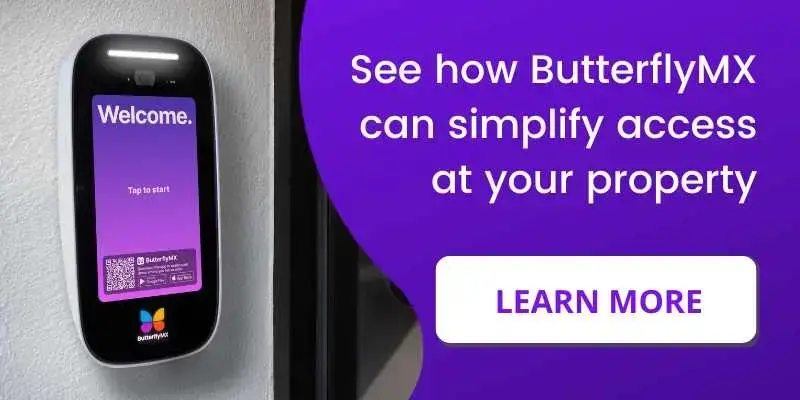Key takeaways:
- An intercom system enables two-way communication and remote visitor access.
- Traditional intercom systems include a base station at the entrance and substations inside the building.
- Intercoms enhance building security, improves communication, and adds property value.

For over a century, intercom systems have helped us secure buildings and simplify property access. Intercoms have the power to improve both safety and convenience at all kinds of properties. From offices and apartment buildings to gated communities and industrial facilities, any property that requires managed visitor access can benefit from an intercom system.
In this post, we examine intercom systems in depth. We discuss their functions, features, and benefits. So, read on to find the answers to your questions about video intercom systems for buildings.
This guide covers:
- What is an intercom system?
- Components of an intercom system
- How does an intercom system work?
- The 9 types of intercom systems
- Intercom system installation
- How much does an intercom system cost?
What is an intercom system?
An intercom system is an electronic device that enables two-way communication between people. It also allows people in a building to grant property access to visitors by opening a door or gate remotely.
Intercom systems have taken many forms throughout history. Early intercom systems required people to talk through metal tubing, which carried their voices like two cans connected by a string. But today’s modern electronic intercoms contain circuitry designed to transmit and receive audio and video digitally.
Intercom systems can be used for many applications, but their primary purpose is to enable communication and property access.
Components of an intercom system
Modern intercom systems consist of two components:
The base station, sometimes called a ‘master station,’ is the main component of an intercom system. It is installed at a property’s entryway.
The base station is connected to one or more substations. Substations are installed throughout the building, such as inside an apartment or office.
Intercom base stations
Intercom system base stations enable visitors outside a building to communicate with visitors inside a building.
The base station controls the entire system as the central piece of an intercom system. Installed at the property’s entrance, the base station must be connected to power, a door release device, and every substation. You can either hardwire the base station to substations or connect them wirelessly.
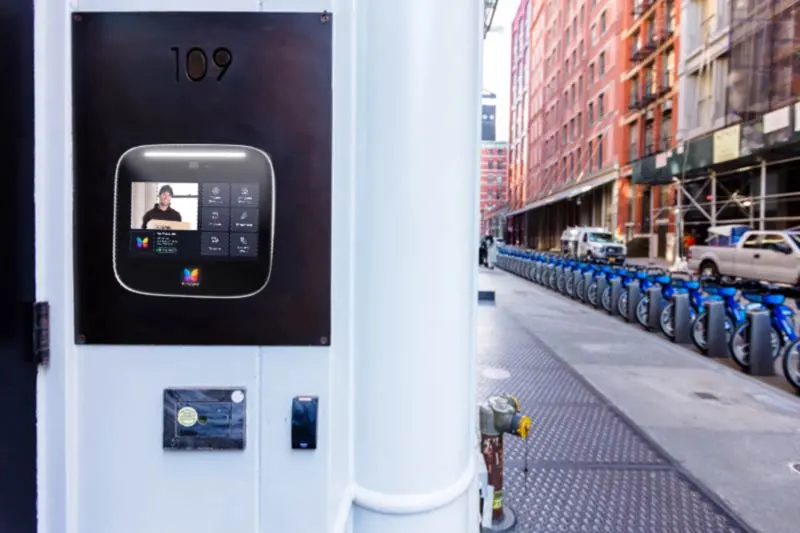
Visitors use the base station to notify tenants of their arrival and communicate with any substation in the building.
Pro tip: Choose a base station with a built-in camera when purchasing an intercom system. The camera adds a layer of security and convenience by letting tenants see who’s at the door before letting them in.
Intercom substations
Intercom system substations allow tenants inside the building to communicate with visitors outside the building and grant visitors access to the property through a ‘door open’ button.
Traditionally, substations were physical pieces of hardware that included a speaker and a microphone. They were installed throughout the building and hardwired directly to the base station.

Today, modern intercom systems ditch the substation hardware and instead rely on people’s smartphones as the intercom substation. This allows tenants to open the door wherever they are and see who is at the door through a live video call.
Pro tip: Find an intercom system that uses smartphones as the intercom’s substations. You’ll get more features, including video calls, remote property access, and keyless entry. You won’t have to pay for additional hardware, wiring, and labor costs to install the intercom substations throughout your building.
Takeaways:
Intercom systems consist of two parts: base stations and substations.
Base stations are installed at the property’s entryway, allowing visitors to communicate with tenants. Substations are installed throughout the building, allowing tenants to communicate with visitors and granting them access to the building.
Base stations are connected to substations through a hardwired or wireless connection. Intercom systems that use smartphones as their base stations save you money on hardware, wiring, and installation.
Recommendations:
- Install an intercom base station at the entryway of your building.
- Choose an intercom system with a camera that wirelessly connects to its substations.
- Smartphones make the best substations because they do not require purchasing and installing additional hardware.
How does an intercom system work?
An intercom system allows visitors to call tenants in a building and then transmit audio and video signals to substation devices so that tenants and visitors can communicate.
The base station captures audio and video and transmits them to substations. The substations then allow tenants to see and speak with visitors before giving them access to the building. Tenants can remotely unlock the door or gate by pressing a button on their device.
Watch how ButterflyMX works:
How to use an intercom
Here’s a step-by-step guide on how to use an intercom:
- Use the intercom device at the door or gate to locate the tenant you want to call.
- Press a button or enter the tenant’s code to call them.
- The tenant answers the call using their in-unit device, cell phone, or landline phone.
- If the tenant wants to grant access, they press a ‘door open’ button on their intercom device to remotely unlock the door or gate.
What are the types of intercom systems?
A wide variety of intercom systems are currently available. Some are wireless, while others are wired. Some are designed for apartment use, while commercial intercom systems are intended for commercial buildings.
Here are the nine most common types of intercom systems:
- Wireless intercoms
- Wired intercoms
- Audio intercoms
- Video intercoms
- Outdoor intercoms
- Apartment intercoms
- Commercial intercoms
- Office intercoms
- Gate intercoms
1. Wireless intercoms
A wireless intercom system can be installed when running wiring throughout the property is too difficult or expensive.
Wireless intercoms rely on invisible radio frequencies known as spectrum, which carry the signal that enables all wireless devices to operate. Whether a wireless intercom can transmit audio, video, or both depends on the portion of spectrum used, also known as the ‘band.’ Today’s wireless network providers use low-frequency bands (under 3 GHz), which are also used to transmit the audio and video signals of wireless intercoms.
Pro tip: If you’re considering a wireless intercom system, ask the intercom provider how the system works. Of course, a direct connection to the internet is best because WiFi signals can be interrupted by external factors like electrical interference. However, if a direct connection is not possible, WiFi or a cellular connection (such as 4/5G) will suffice.
Remember to always test those signals at the location where you’re installing the intercom.
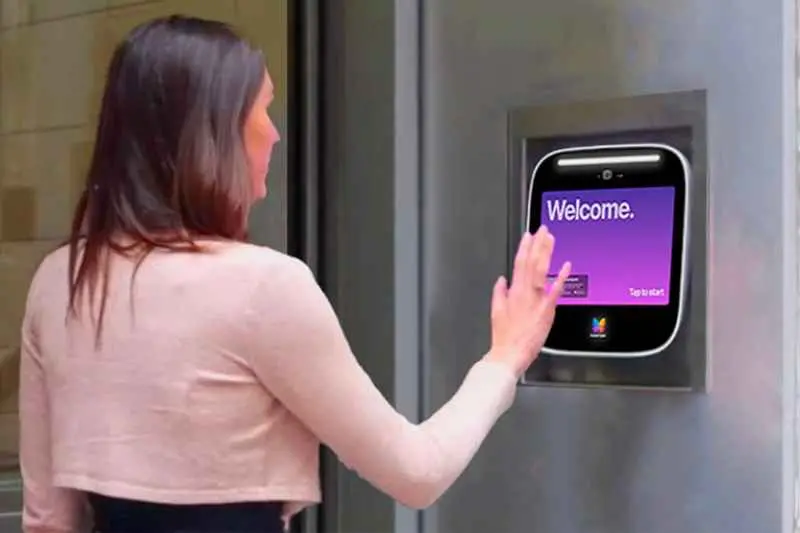
2. Wired intercoms
The difference between a wired and wireless intercom system is its connection to the Internet. All intercoms require some form of wiring—some require more wiring than others.
Cost-effective building intercom systems only require wiring at the location where they’re installed. For example, you’ll need wiring to connect your intercom to your electronic or magnetic door lock.
Other intercoms require wiring throughout the entire building. For example, you might need to run wiring from every substation back to the base station at the property’s entryway.
Pro tip: We recommend connecting your intercom directly to the internet with a Cat 5/6 ethernet cable. This will make your intercom system more secure and reduce the chance of interference from other wireless devices and electrical signals.
3. Audio intercoms
Sometimes called an apartment buzzer, an audio intercom allows visitors to speak with tenants inside the building. If the audio intercom system also has a door release device, the tenant can grant building access to the visitor. Audio intercoms are commonly only seen in older buildings because video intercom systems have replaced them.
Pro tip: Consider a video intercom instead of a buzzer if designing and building a new property. They’re comparable in price with audio intercoms while providing greater functionality. And if you’re considering replacing your audio intercom, a video intercom is a good alternative. But make sure you have the necessary wiring at the location where the intercom will be installed.
4. Video intercoms
In addition to transmitting audio, some intercoms also transmit video.
Video intercoms require:
- A camera to capture the video
- A screen to display it
The ideal video intercom has a built-in camera, but you can also use an external camera. Displaying the video footage requires separate hardware, which you’ll install at various locations throughout the building. Since video requires more bandwidth than audio, connecting a video intercom directly to the internet is best.
Pro tip: When purchasing a video intercom for your building, consider a system that sends video calls to smartphones. This lets tenants see who’s at the door and grants access from anywhere. It also saves you money since you won’t have to purchase and install in-unit hardware.
Watch an overview of the ButterflyMX video intercom systems:
5. Outdoor intercoms
Most properties—especially gated ones—require an outdoor intercom that can withstand the weather year-round. Outdoor intercom systems consist of weatherproof hardware installed outside. Visitors use this hardware to contact residents and request property access.
An outdoor intercom’s weatherproofing standards depend on its IP (ingress protection) rating. The best and most durable intercoms are IP65-rated, meaning they’re dust-tight and protected against water projected from a nozzle. So, if you’re installing any intercom hardware outside, choose a system with an IP65 rating.
6. Apartment intercoms
Designed specifically for multifamily buildings, an apartment intercom system is an electronic device that allows two-way communication between apartment residents and their visitors. Apartment intercoms also allow residents to grant property access to their visitors through a door release mechanism.
Apartment intercom systems require two types of hardware:
- Master station: Installed at the entrance of the building, an apartment intercom master station allows visitors to find and call tenants from a directory. The intercom master station is wired to power, a door lock, and possibly the internet.
- Substations: Residents use an intercom substation installed in their apartment unit to speak with visitors and grant them property access.
Pro tip: Choose an apartment intercom system with a mobile app so your residents can use their smartphone as the substation. That way, residents can see and speak with visitors and be granted access from anywhere, not just their apartment. Besides, purchasing and installing substations in each apartment is expensive due to the hardware, wiring, and labor costs.
7. Commercial intercoms
Commercial intercoms must be able to handle a bit more complexity. In addition to allowing visitors to call an employee inside a multi-tenant building, commercial intercoms must also allow visitors to call the business. This is because a guest might need property access without visiting a specific employee.
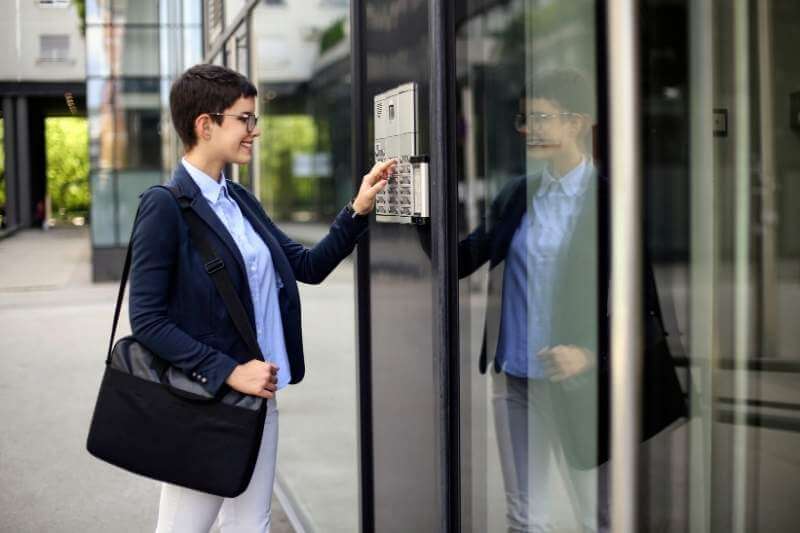
For example, a delivery person might be delivering packages to a company in the building without knowing which employee purchased those items. So, when the delivery person uses the commercial intercom in this scenario, there must be an option to call the ‘front desk’ or ‘receptionist’.
Pro tip: Make sure your multi-tenant commercial intercom allows visitors to call both the companies in the building and the individual employees of each company. That way, you’ll accommodate every visitor regardless of their reason for visiting.
8. Office intercoms
There are two types of office intercom systems: internal and external.
Internal office intercoms enable communication between parties inside an office building, such as employees or coworkers. They can be thought of as walkie-talkies, allowing people in different rooms to speak with each other easily.
External office intercom systems enable communication between office staff and people outside the building (such as visitors and delivery people). They also include a door release device for property access.
Pro tip: Internal office intercom systems are no longer used because smartphones, emails, and messaging apps have replaced them. If you’re looking for an office intercom, you’re probably looking for a commercial intercom system for your business or office building. Commercial intercom systems are necessary for all multi-tenant office buildings.
9. Gate intercoms
At many properties, the front entrance isn’t a door—it’s a gate. A gate intercom system can grant access to cars or pedestrians.
Gate intercom systems are often installed at:
- Gated communities
- Industrial properties
- Parking garage entrances
- Campgrounds
Like other intercom systems, a gate intercom requires a master station and substations so that people on the property can speak to visitors seeking access and open the gate for them.
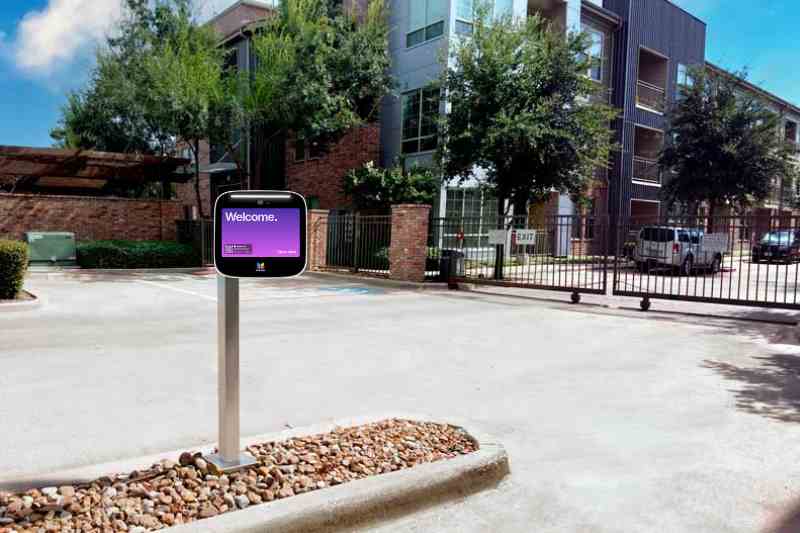
Gate intercoms may include a call button that dials a substation controlled by property staff. This could be a leasing agent, a gate attendant, a front desk, or any other property representative.
Gate intercom systems can be trickier to install because the gate may not be near a building or other structure with a power supply. So, you may need to run wiring a great distance to power it. The location of the property’s gate will dictate the installation’s cost and complexity.
Pro tip: If you’re buying an intercom for a gate, choose a system that only requires three connections: power, internet, and the gate opener. A system that requires wiring between the base station and every substation is more difficult and expensive to install.
Takeaways:
While the basic structure of an intercom always remains the same (a base station with master stations), there are several variations of intercom systems.
Some intercoms require wiring between the base station and every master station, while others operate wirelessly. Intercoms can offer audio communication only (buzzer systems) or audio and video communication (video intercoms).
Intercom systems improve property access for a wide variety of properties. Any property with an entrance that requires managed access will benefit from an intercom system.
You can install an intercom system at:
- Commercial properties (like offices, buildings for non-profit organizations, and industrial properties)
- Residential properties (like apartment buildings, gated communities, and mobile home parks)
Recommendations:
- To choose the right intercom system, consider the type of property (residential vs. commercial) and entryway (door vs. gate) where you install the intercom.
- Instead of an audio intercom, choose a video intercom system so tenants can see visitors before granting them property access.
- Opt for an intercom that’s both vandal-resistant and weatherproof.
- Choose a wireless intercom that doesn’t require wiring throughout the property to reduce installation costs.
- For security and performance, choose an intercom system with a wired connection to the internet.
- Increase curb appeal with an alluring intercom that combines beauty and function.
- Opt for an intercom system that accepts multiple credentials, such as opening from a smartphone, key cards and fobs, and RFID compatibility.
- The best video intercom system for any property connects to an entire suite of access control products for holistic security.
Intercom system installation
The complexity and cost of replacing or installing an intercom system depend on three things:
- The type of intercom
- The wiring
- Location of the install
If you install a video intercom with substations in each apartment unit, the installation will be more complicated and expensive. Purchasing all the hardware and running wiring to each apartment adds up. However, if you’re installing a wireless intercom that sends signals to a tenant’s smartphone, the installation will cost less.
Where you install the intercom system matters, too. If you’re replacing an existing intercom system with the wiring and backbox already in place, the installation will be easier and less expensive. But if you need to cut open a wall or break apart some bricks at an industrial complex, expect the installation to be more difficult and costly.
Pro tip: Installing an intercom system is often more expensive than the intercom itself. The cost of additional parts, wiring, and labor add up quickly. To ensure you’re not paying more than you have to, get a quote from several certified installers in your area. This way, you can compare their quotes and determine which suits you best.
How much does an intercom system cost?
An intercom system costs $500 to $5000, sometimes more, depending on its features and functionality. This cost ranges from inexpensive to luxury and does not include ongoing maintenance or servicing, which can include upgrades, replacement parts, or additional fees.







